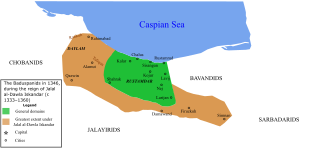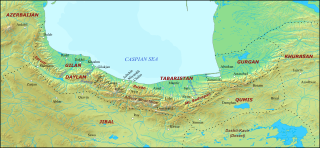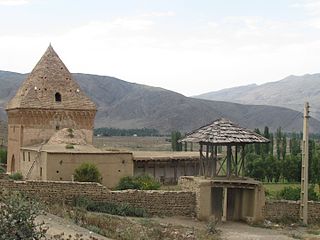Related Research Articles

The Baduspanids or Badusbanids, were a local Iranian dynasty of Tabaristan which ruled over Ruyan/Rustamdar. The dynasty was established in 665, and with 933 years of rule as the longest dynasty in Iran, it ended in 1598 when the Safavids invaded and conquered their domains.
Jahangir III, was the last ruler of the Paduspanid branch of Nur. He was the son and successor of Sultan Aziz. In 1593/94, he traveled to the court of the Safavid Shah Abbas I, where he handed over his domains to him, and spend the rest of his life in a property near Saveh which Abbas had given to him.
Jalal al-Dawla Iskandar was the ruler (ustandar) of the Baduspanids from 1333 to 1360. Under his rule, the kingdom reached its zenith. Taking advantage of the collapse of the Mongol Ilkhanate in 1335, he expanded his rule into the southern Alborz, ruling an area stretching from Qazvin to Simnan. In 1346, he founded the town of Kojur and conquered the region of Daylam. In 1360, he was mortally wounded by his bodyguard during a ruckus at a drinking party. He died three days later, and was succeeded by his brother Fakhr al-Dawla Shah-Ghazi.
Kayumarth III, was the fifth ruler of the Paduspanid branch of Kojur. He was the son and successor of Ka'us III.
Jahangir IV, was the last ruler of the Paduspanid branch of Kojur. He was the son and successor of Sultan Mohammad ibn Jahangir.
Iskandar-i Shaykhi, was an Iranian ispahbad from the Afrasiyab dynasty, who ruled Amul as a Timurid vassal from 1393 to 1403. He was the youngest son of Kiya Afrasiyab, who had initially established his rule in eastern Mazandaran from 1349 to 1359, but was defeated and killed by the local shaykh Mir-i Buzurg, who established his own dynasty—the Mar'ashis—in the region. Together with some supporters and two nephews of his father, Iskandar initially took refuge in Larijan, but later left for Herat, where entered into the service of the Kartid ruler Ghiyath al-Din II.
Ardashir I, was the ruler of the Bavand dynasty from 1173 to 1205. He was the son and successor of Hasan I.
Hasan I, was the ruler of the Bavand dynasty from 1165 to 1173. He was the son and successor of Shah Ghazi Rustam IV. He was murdered in 1173 by his Turkic slave-soldiers (ghilman) and was succeeded by his son Ardashir I.

Ruyan, later known as Rustamdar (رستمدار), was the name of a mountainous district that encompassed the western part of Tabaristan/Mazandaran, a region on the Caspian coast of northern Iran.

Kayumarth I was the ruler (ustandar) of the Baduspanids from 1394 to 1453, with a three-year interruption. An active expansionist ruler, his kingdom experienced a resurgence during his long reign, which included the reconquest of Rustamdar. He was often at odds with his suzerain, the Timurid ruler Shah Rukh. After his death, a dynastic struggle followed, which resulted in his kingdom being split up by his sons Iskandar IV and Ka'us II, in Kojur and Nur respectively.
Fakhr al-Dawla Shah-Ghazi was the Baduspanid ruler (ustandar) of Rustamdar from 1360 to 1379. He is notable for sponsoring the composition of the history chronicle Tarikh-i Ruyan by Awliya Allah Amuli. He died in 1379 and was succeeded by his son Adud al-Dawla Qubad.
Adud al-Dawla Qubad was the Baduspanid ruler (ustandar) of Rustamdar from 1379 to 1381.
Sayyid Fakhr al-Din was a Mar'ashi prince, who ruled the region of Rustamdar from 1381 to 1390. He shared power with his three other brothers; Kamal al-Din I in Sari; Rida al-Din in Amul; and Sharaf al-Din in Karatughan. Together, they ruled a realm encompassing all of Mazandaran, reaching as far west to the city of Qazvin. They had inherited this realm from their father Mir-i Buzurg, the founder of the Mar'ashis.
Sa'd al-Dawla Tus was the Baduspanid ruler (ustandar) of Rustamdar from 1390 to 1394. He was a son of ustandar Taj al-Dawla Ziyar.
Taj al-Dawla Ziyar was the Baduspanid ruler (ustandar) of Rustamdar from 1325 to 1333. He succeeded to the throne after instigating the murder of his predecessor and brother Nasir al-Din Shahriyar through his son Iskandar.
Ostandar or Ustandar was an administrative title wielded by provincial governors under the Sasanian Empire. They governed the royal lands, known as the ostan. The title was later assumed by the Baduspanids of Ruyan, starting with Shahriyar III ibn Jamshid.
Nasir al-Din Shahriyar was the Baduspanid ruler (ustandar) of Rustamdar from 1317 to 1325. He was the brother and successor of Shams al-Muluk Muhammad.
Shams al-Muluk Muhammad was the Baduspanid ruler (ustandar) of Rustamdar from 1312/3 to 1317. He was the son and successor of Kay Khusraw.
Namawar Shah Ghazi was the Baduspanid ruler (ustandar) of Rustamdar from 1272/3 to 1301/2. He was the son and successor of Shahragim.
Baduspan I or Padusban I was the first Ispahbad and the founder of Baduspanid state. He reigned approximately from 665 to 694.
References
- 1 2 Madelung 1988, pp. 385–391.